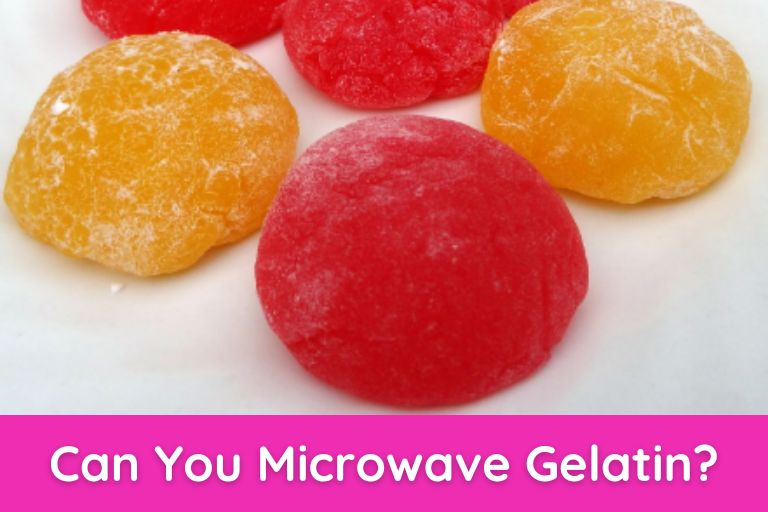Gelatin, a protein derived from animal collagen, is a versatile ingredient used in a wide range of recipes and food products. However, there has been a prevailing misconception that gelatin cannot be microwaved.
This blog post aims to dispel this myth and delve into the science behind microwaving gelatin. We will explore its safety, provide tips for successful microwaving, address common misconceptions, and even share some delicious microwave-friendly gelatin recipes.
What is Gelatin?
Gelatin is a translucent, odorless, and tasteless substance that is commonly used as a gelling agent in various food products. It is derived from the collagen found in animal bones, skin, and connective tissues.
Gelatin has unique properties that allow it to form a gel-like structure when mixed with liquid and cooled. It is widely used in desserts, candies, and even savory dishes like aspics.
Microwave Safety Considerations
Before diving into microwaving gelatin, it’s important to understand general microwave safety guidelines.
This includes using microwave-safe containers, adjusting power levels, and avoiding overheating. We should always follow these precautions to ensure the safety of our food and prevent any accidents.
Microwaving Gelatin: The Science Behind It
Contrary to popular belief, gelatin can indeed be microwaved. Microwaves work by emitting electromagnetic waves that cause water molecules to vibrate, generating heat.
When microwaving gelatin, the heat from the microwave will cause the gelatin molecules to break down temporarily, allowing it to become liquid. Once cooled, the gelatin molecules will reassemble, forming the desired gel-like consistency.
Tips for Microwaving Gelatin
To successfully microwave gelatin, there are a few key tips to keep in mind. Firstly, following the recipe instructions and adjusting cooking times and power levels accordingly is crucial.
It’s also important to avoid overheating the gelatin, as excessive heat can degrade its structure. By being mindful of these considerations, we can achieve optimal results when microwaving gelatin.
Common Misconceptions about Microwaving Gelatin
There are several misconceptions surrounding microwaving gelatin that need to be addressed. One common concern is that microwaving gelatin will completely destroy its gelling properties.
However, studies have shown that microwaving gelatin does not cause significant degradation but instead temporarily disrupts its structure. This allows for the gelatin to return to its gelled state once cooled.
Recipes and Applications
Now that we’ve debunked the myth and established the safety of microwaving gelatin, let’s explore some exciting recipes and applications. From quick and easy gelatin desserts to innovative savoury dishes like gelatin salads or aspics, the microwave can be a convenient tool for preparing gelatin-based creations. We encourage readers to experiment, adapt recipes, and unleash their creativity when using microwaved gelatin.
FAQ:
How do you heat up gelatin?
Gelatin can be heated by dissolving it in a liquid and then applying heat to the mixture. This can be done on a stovetop using low heat or in a microwave by following specific guidelines.
Can you microwave jelly?
Yes, jelly can be safely microwaved. However, it is important to follow proper guidelines, such as using a microwave-safe container and adjusting power levels to prevent overheating and boiling.
How do you cook Jello in the microwave?
To cook Jello in the microwave, start by mixing the gelatin powder with water as per the package instructions. Place the mixture in a microwave-safe container and heat it in short intervals, stirring in between, until the gelatin is fully dissolved. Then proceed with chilling and setting the Jello in the refrigerator.
Does heat destroy gelatin?
Heat can temporarily break down the structure of gelatin, but it does not destroy it. Gelatin can return to its gelled state when cooled. It is important not to overheat or boil gelatin, as excessive heat can degrade its gelling properties.
What happens to gelatin when heated?
When heated, gelatin molecules begin to unfold and form a liquid state. This allows the gelatin to dissolve and mix with other ingredients. Once cooled, the gelatin molecules reassemble, forming a gel-like consistency.
Is it okay to boil gelatin?
Boiling gelatin is not recommended as prolonged exposure to high heat can degrade its gelling properties. It is best to heat gelatin gently until it dissolves and then cool it to allow it to set properly.
Does gelatin need to be boiled?
Gelatin does not need to be boiled. It can be dissolved in warm or hot liquid, and then the mixture should be cooled to allow the gelatin to set.
Can you soften gelatin?
Yes, gelatin can be softened by soaking it in cold water for a few minutes before using. This helps to hydrate the gelatin and ensure it dissolves properly when heated.
What temperature kills gelatin?
Gelatin begins to lose its gelling properties at temperatures above 95°F (35°C). Prolonged exposure to high temperatures can further degrade gelatin.
What kills gelatin?
Gelatin can be affected by certain enzymes, such as those found in fresh pineapple, kiwi, ginger, and papaya. These enzymes can break down the structure of gelatin, preventing it from setting properly.
What are the disadvantages of gelatin?
Some potential disadvantages of gelatin include its animal-derived source, which may not be suitable for vegetarians or vegans. Gelatin also has limited nutritional value and may not be suitable for individuals with certain dietary restrictions or allergies.
Is gelatin heat stable?
Gelatin is stable at low to moderate heat levels. However, prolonged exposure to high heat or boiling can degrade its gelling properties.
How do you liquefy gelatin?
Gelatin can be liquefied by dissolving it in warm or hot liquid, such as water or fruit juice. The mixture should be stirred until the gelatin is fully dissolved and then cooled to allow it to set.
Why do we heat gelatin?
Heating gelatin is necessary to dissolve it and create a liquid mixture that can be incorporated into recipes. It allows the gelatin to mix and combine with other ingredients before setting into a gel-like consistency.
Conclusion
In conclusion, the myth that gelatin cannot be microwaved is simply not true. Gelatin can be safely microwaved, and the process does not destroy its gelling properties.
By understanding the science behind microwaving gelatin, following proper guidelines, and experimenting with recipes, we can harness the convenience of the microwave to create delicious gelatin-based dishes.
So go ahead, grab your favourite gelatin recipe, and confidently explore the possibilities of microwaving gelatin. It’s time to unlock a whole new world of culinary adventures!




